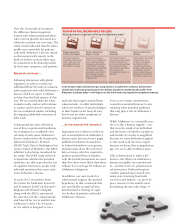Eli Lilly 2012 Annual Report Download - page 21
Download and view the complete annual report
Please find page 21 of the 2012 Eli Lilly annual report below. You can navigate through the pages in the report by either clicking on the pages listed below, or by using the keyword search tool below to find specific information within the annual report.
9
• Strattera is protected by a patent covering its use in treating attention deficit-hyperactivity disorder
(2016), as extended by pediatric exclusivity (2017).
• Tradjenta and Jentadueto are protected by a compound patent (2023), and Boehringer Ingelheim has
applied for a patent extension to 2025 under the patent restoration laws.
Outside the U.S., important patent or data package protection includes:
• Alimta in most major European countries (compound patent 2015, vitamin dosage regimen patent
2021)
• Cialis in major European countries (compound patent 2017)
• Cymbalta in major European countries (data package protection August 2014)
• Zyprexa in Japan (compound patent 2015).
U.S. patent protection or data package protection for our new molecular entity that has been submitted for
regulatory review is as follows (Additional information about this molecule is provided in Item 7,
"Management’s Discussion and Analysis—Late-Stage Pipeline”):
• Liprotamase, if approved, would be protected for at least the five-year data package protection period
following U.S. regulatory approval.
Worldwide, we sell all of our major products under trademarks that we consider in the aggregate to be
important to our operations. Trademark protection varies throughout the world, with protection continuing in
some countries as long as the mark is used, and in other countries as long as it is registered. Registrations
are normally for fixed but renewable terms.
Patent Licenses
Most of our major products were discovered in our own laboratories and are not subject to significant license
agreements. Two of our larger products, Cialis and Alimta, are subject to patent assignments or licenses
granted to us by others.
• The compound patent for Cialis is the subject of a license agreement with GlaxoSmithKline (Glaxo),
which assigns to us exclusively all rights in the compound. The agreement calls for royalties of a
single-digit percentage of net sales. The agreement is not subject to termination by Glaxo for any
reason other than a material breach by Lilly of the royalty obligation, after a substantial cure period.
• The compound patent for Alimta is the subject of a license agreement with Princeton University,
granting us an irrevocable exclusive worldwide license to the compound patents for the lives of the
patents in the respective territories. The agreement calls for royalties of a single-digit percentage of
net sales. The agreement is not subject to termination by Princeton for any reason other than a
material breach by Lilly of the royalty obligation, after a substantial cure period. Alimta is also the
subject of a worldwide, nonexclusive license to certain compound and process patents owned by
Takeda Pharmaceutical Company Limited. The agreement calls for royalties of a single-digit
percentage of net sales in countries covered by a relevant patent. The agreement is subject to
termination for material default and failure to cure by Lilly and in the event that Lilly becomes
bankrupt or insolvent.
Patent Challenges
In the U.S., the Drug Price Competition and Patent Term Restoration Act of 1984, commonly known as the
Hatch-Waxman Act, made a complex set of changes to both patent and new-drug-approval laws for human
pharmaceuticals. Before the Hatch-Waxman Act, no drug could be approved without providing the FDA
complete safety and efficacy studies, i.e., a complete New Drug Application (NDA). The Hatch-Waxman Act
authorizes the FDA to approve generic versions of innovative human pharmaceuticals (other than biologics)
without such information by filing an Abbreviated New Drug Application (ANDA). In an ANDA, the generic
manufacturer must demonstrate only “bioequivalence” between the generic version and the NDA-approved
drug—not safety and efficacy.
























